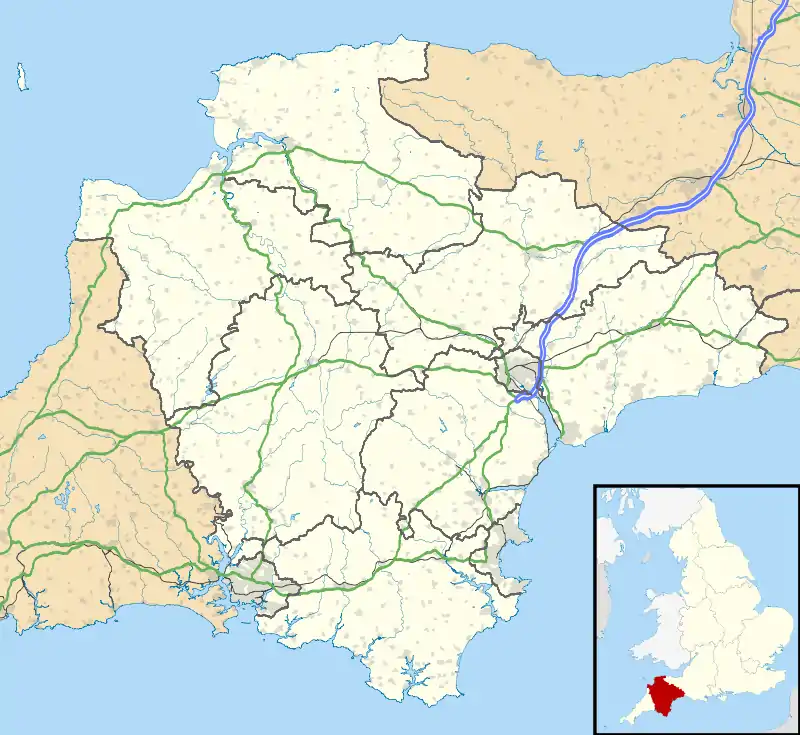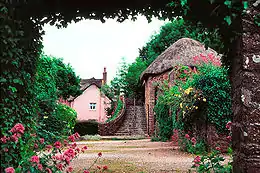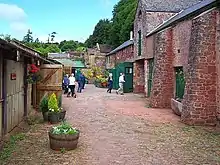Cockington
Cockington is a village near Torquay in the English county of Devon. It has old cottages within its boundaries, and is about a half a mile away from Torquay. Bus service 62 (Torquay circular) calls at the village five times per day (Mon-Fri) and is operated by Torbay Buses.
| Cockington | |
|---|---|
 Cockington Location within Devon | |
| Population | 10,636 (ward 2011)[1] |
| OS grid reference | SX8963 |
| Unitary authority | |
| Ceremonial county | |
| Region | |
| Country | England |
| Sovereign state | United Kingdom |
| Post town | Torquay |
| Postcode district | TQ2 |
| Dialling code | 01803 |
| Police | Devon and Cornwall |
| Fire | Devon and Somerset |
| Ambulance | South Western |
| UK Parliament | |
History

_(LOC)_(16236757211).jpg.webp)
The village was probably founded 2,500 years ago during the Iron Age with evidence of two hill forts on either side of Cockington valley. Little is known about Cockington from that point up until the remains of a small Saxon village were found near the Drum Inn. The evidence from this village shows that it was primarily a fishing and farming village. The first official documentation of the village was in the 10th century. The manor was owned by Alric the Saxon, before William Hostiarus, William de Falesia and Robert FitzMartin, who passed it down to his son Roger, who renounced his name to become Roger de Cockington. The Cockington family owned Cockington Estate from 1048–1348. The Cary family (this particular branch included George Carey (c. 1541–1616)) owned the court from 1375 to 1654. It was then sold to the Mallock family a family of rich silversmiths from Exeter, who owned it from 1654 to 1932 when they sold the estate to the Torquay Corporation.[2]
Buildings
There are several buildings of note in Cockington.
Cricket Pavilion and grounds

The park which is now home to the cricket grounds was originally a medieval deer park. Cricket started to be played on it in 1947. The current cricket pavilion was built after the original burnt down ten years ago.
Drum Inn
The Grade II listed thatched Drum Inn[3] is the local public house and restaurant in Cockington. Designed by Sir Edwin Lutyens, it opened in 1936 and cost £7,000 to build. Covering 522 square metres, it uses 16th century styled bricks, made in Belgium to Lutyens specifications. The two largest chimney stacks are evocative of the shape of another Lutyens creation, the Cenotaph in London.[4] The Drum Inn occupies the site of a former sawmill and was the flagship project of Cockington Trust Ltd, who were proposing to build a new village.[4] It was the only building they were able to complete before the village was sold in 1946.[5] Originally intended to be called 'The Forge Inn', the name was changed as the Cockington Trust thought it might be 'Predudicial to the celebrated forge in the village'.[4]
The pub sign depicting an Elizabethan soldier beating a drum, is attributed to be from the studio of Dame Laura Knight.[6] The original was painted on a solid sheet of copper and today it hangs on a wall inside the pub, with a facsimile in its place outside.[7] Sir Alan Charles Laurence Whistler, the noted poet and glass engraver presented Sir Edwin Lutyens with a poem titled 'The Drum', engraved on a glass pane that was originally placed in a lounge window.[4] It's now framed and is on display inside the pub.
The Almshouses
The Almshouses consist of seven terraced cottages built during the reign of King James I of England by the Cary family to house the poor and those who could not work within the village. When the Mallock family took over the Cockington estate, the almshouses fell into disrepair. They were rebuilt between 1790 and 1810.
Cockington Court
The Court[8] was the mansion house of the Mallock family, and remains the focal point of the estate. Originally built in the 16th century, it has few architectural features remaining from then, but was altered and extended several times, particularly in 1673 by Rawlyn Mallock and about 1820 by the Rev'd Roger Mallock. He had the top floor removed and the interior remodelled. Its historical significance merits great care in maintaining its existing fabric and in ensuring new elements are sympathetically designed.[9]

Cockington Court was built over the remains of a medieval court. A far cry from the days of the Cary family when it was an actual court, it is now filled with various arts and crafts workshops.[10][11]
In her youth, Agatha Christie regularly visited Cockington. Her novel Why Didn't They Ask Evans? is dedicated to Christopher Mallock. The Mallock family were friends of Christie's from the years before her first marriage. The Mallocks staged amateur theatricals at Cockington Court, in which Christie, managing to overcome her usual crippling shyness, took part.[12][13]
Other notable buildings
- Cockington Church which has been estimated to have been standing since 1069 [14] built by William de Falaise.[14]
- A water mill that is in the middle of the village;
- Cockington Forge, which has been in the same place in the village for 500 years.
Notable residents
Chronologer Robert Cary was born in Cockington in about 1615.[15] Robert Sweet (1782-1835), horticulturalist and author, was also born in the village.[16]
See also
References
- "Torbay ward 2011". Retrieved 5 April 2015.
- "Archived copy" (PDF). Archived from the original (PDF) on 3 March 2016. Retrieved 18 August 2015.CS1 maint: archived copy as title (link)
- Historic England (10 April 1987). "Details from listed building database (1306171)". National Heritage List for England. Retrieved 7 August 2019.
- Read, Brian (2015). Cockington Bygones - A history of the Manors of Cockington and Chelston and the Parish of Cockington. Portcullis Publishing. p. 124. ISBN 9780953245086.
- Read, Brian (2015). Cockington Bygones - A history of the Manors of Cockington and Chelston and the Parish of Cockington. Portcullis Publishing. p. 17. ISBN 9780953245086.
- Historic England (3 May 1994). "Details from listed building database (1206758)". National Heritage List for England. Retrieved 7 August 2019.
- "Torbay Council Planning Application P/2019/0034". Torbay Council. 10 May 2019. Retrieved 7 August 2019.
- "Archived copy" (PDF). Archived from the original (PDF) on 19 July 2014. Retrieved 15 July 2014.CS1 maint: archived copy as title (link)
- "Archived copy" (PDF). Archived from the original (PDF) on 19 July 2014. Retrieved 15 July 2014.CS1 maint: archived copy as title (link)
- "Cockington Court Craft Centre". Archived from the original on 13 June 2010. Retrieved 16 May 2010.
- "Cockington Court Centre for Arts, Crafts and Culture". Archived from the original on 13 June 2010. Retrieved 16 May 2010.
- "Cockington Court history". Archived from the original on 13 June 2010. Retrieved 16 May 2010.
- "The Manor House". Archived from the original on 13 June 2010. Retrieved 16 May 2010.
- https://toplocalplaces.com/united-kingdom/torquay/church/cockington-parish-churches/187058691318449
- Hutton, Charles (1815). A philosophical and mathematical dictionary containing... memoirs of the lives and writings of the most eminent authors, Volume 1. Charles Hutton. p. 278.
- Blewitt, Octavian (1832). The panorama of Torquay: a descriptive and historical sketch of the district comprised between the Dart and Teign. Simkin. pp. 270, 274.